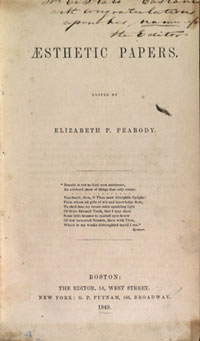- Nature
- An Oration Delivered Before the Phi Beta Kappa Society
- Walden; Or, Life in the Woods
- Leaves of Grass
- Aesthetic Papers
- Woman in the Nineteenth Century
- Passage to India
- Democratic Vistas
- Brook Farm: Historic and Personal Memoirs
- Years of Experience: An Autobiographical Narrative
- The Blithedale Romance
- Record of Conversations on the Gospels, Held in Mr. Alcott's School

As in the sixties, the "new consciousness" in America in Emerson's time made itself manifest across the whole range of cultural expression, from social life and religion to art and politics. This volume, for example, contains the first publication of Hawthorne's "Main Street," but it is now best-known for an essay called "Resistance to Civil Government, by H.D. Thoreau, Esq." In our time the essay is better-known as "Civil Disobedience." In this work Thoreau describes how he went to jail rather than pay taxes to support the Mexican War and the slave system that he felt was the real reason America was fighting in Mexico. Neither the essay nor Thoreau's act of protest attracted much attention among his contemporaries, but it later inspired Mahatma Gandhi, who read it while in jail in South Africa, and through him Martin Luther King. Thoreau's example was also a major inspiration to the anti-war movement of the sixties. "Break the law," Thoreau writes, "Let your life be a counter friction to stop the machine." Interested in many forms of radical change, from education to utopian communities, Elizabeth Palmer Peabody herself was an important figure in the cultural revolution of the 1840's and 1850's. Henry James caricatures her as Miss Birdseye in The Bostonians. Shown is a signed presentation copy of the first edition.

